Carl Zeiss Jena 8x30 Deltrintmo
Bauart 1 und 2 (3)Das Deltrintmo* 8x30 wurde ab 1920 gefertigt. Es ist ein Weitwinkelglas mit 8,5° (150m/1000m) Gesichtsfeld. Im 1920er Katalog T215 (englisch) wird sogar ein 8,75° und 154m Gesichtsfeld angegeben.Das 1. abgebildete Exemplar mit der Seriennummer 1282709 stammt von 1925. Die Ledertasche trägt am oberen vorderen Rand das Carl Zeiss Symbol. Ein Exemplar mit Seriennummer 1391401 (1927) ist am unteren Deckel mit dem Namen der britischen Vertreiberfirma "Negretti & Zambra" gekennzeichnet. Das dritte Exemplar mit Seriennummer 1800371 stammt von 1937. Ein wesentlicher Unterschied der beiden Exemplare (Bauart 1 und 2) ist der Durchmesser der Okularlinse. Beim ersten und zweiten Exemplar ist es jeweils 19mm (Bauart 1, auch 2 Kerben am Fassungsrand zum Abschrauben der Linsenfassung), beim dritten 15,5mm (Bauart 2 ab c. 1926 bzw. Variante 3 ab 1932) im Durchmesser. Ab 1932 wurde das Okularlinsensystem mit einer asphärischen Linse verbessert (sozusagen 3. Bauart). Ein anderer Unterschied war das verwendete Metall (Aluminium vs. Elektron o. ä.) für die Bauteile und folglich das reduzierte Gewicht – beim ersten 257g, beim zweiten 180g (s. tatsächliche Gewichtsmessungen unten). Vgl. a. Seeger: Zeiss Handferngläser 1919-1945,2015, S. 144ff. |
Type 1 and 2 (3)The Deltrintmo* 8x30 was produced since 1920. It is a wide-angle glass with a 8.5° (150m/1000m) field of view. In the T215 (English) catalogue from 1920 the f.o.v. is even said to be 8.75° and 154m. The first specimen depicted with the S/N 1282709 dates from the 1925. The leather case is marked with the Carl Zeiss symbol at the top front edge.Another model with the serial number 1391401 (1927) is inscribed on the bottom cover plate with the name of the British distributor "Negretti & Zambra". The third specimen with serial number 1800371 dates from 1937. The main difference between the two pieces (type 1 and 2) is the diameter of the ocular lens, i.e. 19mm on the first two specimen (type 1, also two slots in the frame to unscrew it), 15.5mm on the third specimen (type 2). Since 1932, the ocular lens system was improved with an aspheric lens (type 3 so to speak). Other differences are the used metal (aluminium vs. Electron or a similar alloy) and resulting from it the reduced weight: 257g versus 180g (cf. real measurements below). Also cf. Seeger: Zeiss Handferngläser 1919-1945,2015, p . 144ff. |

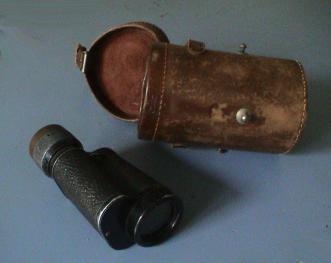
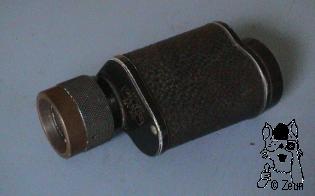
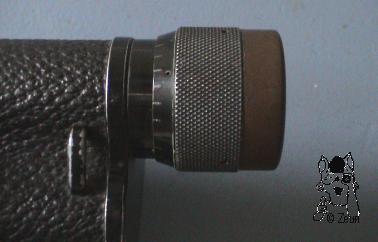
| Das Deltrintmo hat die Bauform eines typischen Porro-1-Glases. Das Gehäuse und die einfach verschraubten Deckel sind aus Aluminium (später Leichtmetalllegierung). Es hat eine eingegossene Trageriemenöse und ist mit strukturiertem Hartgummi ummantelt. Das Okular- und Objektivstück sowie die Deckel sind schwarz lackiert. Es gibt eine komplett umlaufende Dioptrienskala mit plus/minus-5-Markierung. Die Augenmuschel ist aus Bakelit. Das Exemplar mit Seriennummer 1282709 hat eine Kreuzriffelung des Fokussierungsteils, während die anderen Exemplare eine vertikale Riffelung aufweisen. | The Deltrintmo has the typical Porro I design. The body and the cover plates having one screw are made of aluminium (later: light metal alloy). It has a cast-in strap lug and a textured Ebonite covering. The eyepiece, the objective frame, and the cover plates are lacquered black. The eyepiece has a dioptre scale running completely around the ocular, having plus to minus five markings. The eyecup is made of Bakelite. The specimen with the serial number 1282709 has a cross-wise knurling of the focusing ring while the other two specimen have a vertical knurling. |
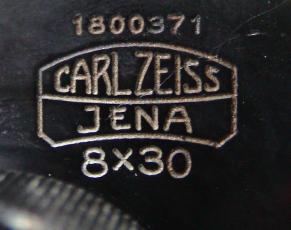
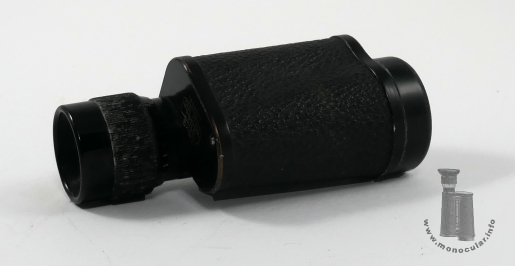

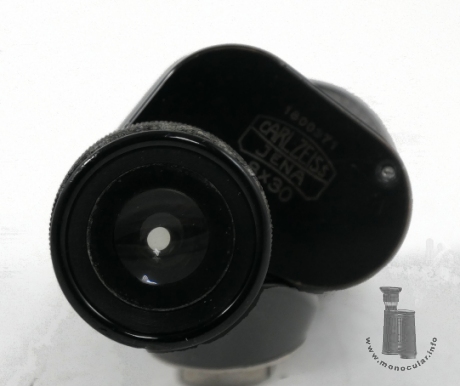
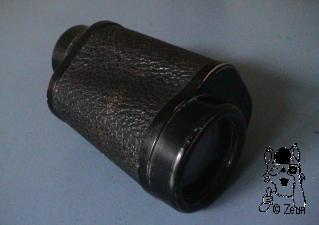
| Länge: 109 - 114mm; Breite: oben 50x50mm - unten 54x54mm; Objektivtubus Ø 40,5mm; Okularstück Ø 28mm; Fokussierungsring Ø 35mm; Augenmuschel Ø 33,5mm; Austrittspupille Ø 3,75mm; Gewicht: #1282709 256g, #1391401 260g, #1800371 180g. Die Augenmuschel der ersten zwei Exemplare ist 10mm hoch, die der Ser.nr. 1800371 ist 11,5mm hoch. |
Length: 109 - 114mm; size: top 50x50mm - bottom 54x54mm; objective tube: Ø 40.5mm; eyepiece Ø 28mm; focusing ring Ø 35mm; eyecup Ø 33.5mm; exit pupil Ø 3,75mm; weight: #1282709 256g, #1391401 260g, #1800371 180g. The eyecup of the first two specimen measures 10mm in height, the eyecup of the model with serial number 1800371 is 11.5mm high. |
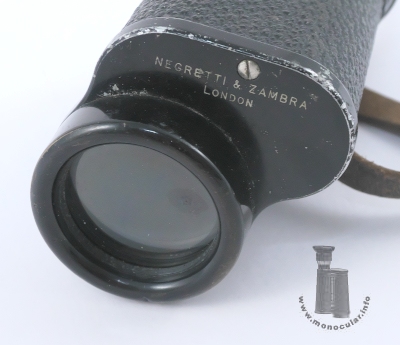
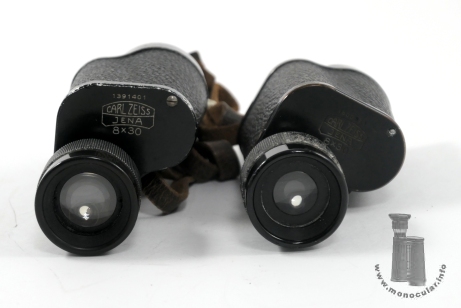
| Kein echtes Monokular, sondern die gut von vom Brückenansatz befreite und neu belederte rechte Hälfte eines Deltrentis, ist das Exemplar mit Seriennummer 1156785 aus einer 300 Stück-Serie Ferngläser von 1922. Der untere Deckel trägt die Angaben: "Mr. Le Brocq | S.S. Kinfauns Castle | 9. September 1922". Die "Kinfauns Castle" war ein Dampfschiff (steam ship = S. S.) der Union-Castle-Line , welches nach einer schottischen Burg benannt wurde und 1899 in Glasgow vom Stapel lief. Es wurde bis 1927 eingesetzt, u.a. als Truppentransporter. Das Datum bezieht sich auf den Tag der Rettung der Seeleute und Passagiere des gekenterten deutschen Schiffes 'Hammonia' in der Biskaya durch die Kinfauns Castle, auf der Cpt. Le Brocq 1. Offizier war. Für seinen Einsatz bedankte sich die Hamburg-Amerika Linie (Reederei HAPAG) mit einem silbernen Zigarettenetui und einem Fernglas - somit wohl das besagte "Deltrentis". (s. a. Quelle: The Singapore Free Press and Mercantile Advertiser (1884-1942), 21 September 1934, Seite 12). Somit stimmen auch Produktionsjahr des Fernglases und dessen Überreichung an Le Brocq überein. |
Although no genuine monocular the specimen with the serial number 1156785 from a 300 pieces batch of 1922 is a right half of a Deltrentis of which the bridge was perfectly removed and well covered with new leather. The lower cover bears the engraving: "Mr. Le Brocq | S.S. Kinfauns Castle | 9. September 1922". The "Kinfauns Castle" was steam ship (S. S.) of the Union-Castle Line named after a Scottish castle, and was launched in Glasgow in 1899. It served as a troop transporter among other until 1927. The date refers to the day when the Kinfauns Castle rescued the crew and passengers of the German vessel 'Hammonia' in the Biscaya. Cpt. Le Brocq was chief officer then. The Hamburg-America Line (HAPAG) thanked him with a silver cigarette case and a binocular - hence obviously that "Deltrentis". (cf. source: The Singapore Free Press and Mercantile Advertiser (1884-1942), 21 September 1934, page 12). So the year of production of the binoculars and its handover to Le Brocq match. |
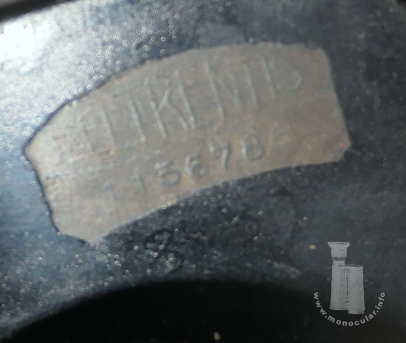

| * Anmerkung: Da das Doppelglas/Fernglas mit Einzelokulareinstellung als "Deltrentis" bezeichnet wurde, hätte das monokulare Modell eher "Deltrentmo" heißen sollen. Die Hälften eines Deltrintem mit Mitteltrieb entsprächen nicht direkt dem Monokular (vgl. adaptierte Hälfte oben). | * Annotation: As the binocular with individual focusing eyepieces was named "Deltrentis", the monocular model should rather have been called "Deltrentmo". The halves of a Deltrintem with central focusing would not directly make up a monocular (cf. above: adapted half). |
Fotos: Zeun

